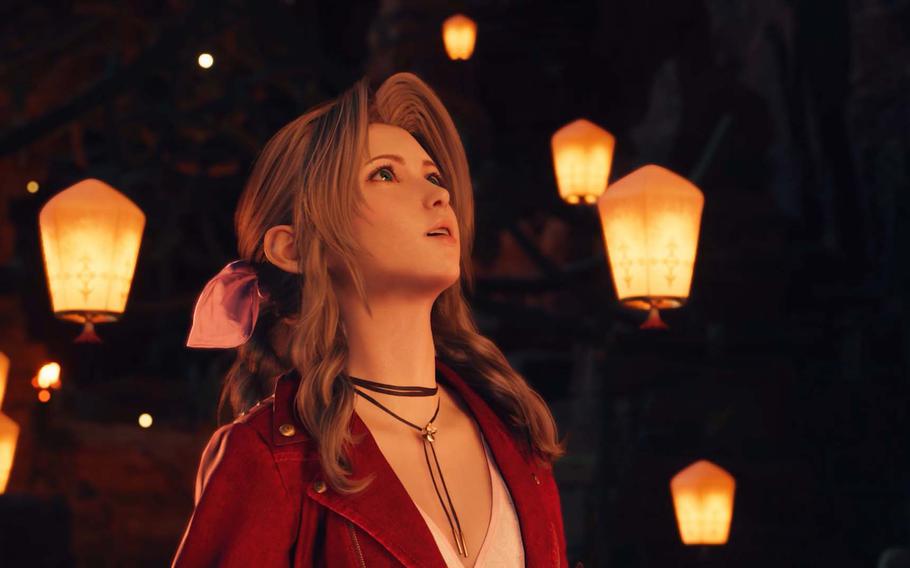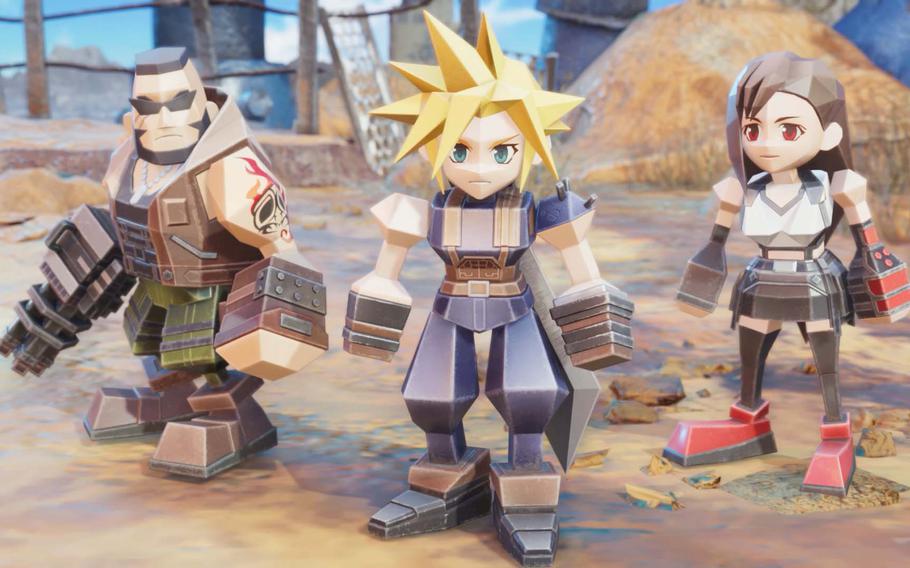
In the 1997 original Final Fantasy VII game, players needed to use their imaginations with crude, faceless, blocky 3D models. The graphics of Rebirth, however, are so vastly improved that we can see, for example, the creases in its soulful characters’ faces and the shadows they cast against the wall. (Square Enix)
Final Fantasy VII is one of the most beloved video game stories ever told because of its exploration of personal identity: how it’s shaped through our memories and through our relationships with the people around us. It is deeply personal and emotionally immersive.
Final Fantasy VII Rebirth, which was just released on the PlayStation 5, is like your favorite ex from years ago suddenly reemerging into your life — prettier than ever, her spirits ever brighter and adoration for you still in bloom. It can be as exciting as it is destabilizing. It’s hard to be productive when you’re forced to examine the time and space between who you once were and who you are today. The characters of Final Fantasy VII once again wreaked havoc on my emotions.
I missed a date for this. I missed a day of work at my second job. I skipped a long-delayed dental appointment. I spilled coffee all over myself twice, something I have never done. Nothing can wreck a life quite like a good Final Fantasy game. Here, then, is the best Final Fantasy of the century, the greatest Square Enix title published since Final Fantasy X in 2001.
It might seem a shame that such an achievement is saddled only to a remake of a 1997 game, especially the second in a planned “remake” trilogy. But this is Final Fantasy VII, arguably the greatest story told in video games, and among the most historically important titles of the medium. It helped established the Sony PlayStation as a game platform. It pushed the boundaries of 3D narrative storytelling. If the writers of Square Enix never dream up a more magical world with more charming, distinctive characters, it is an understandable failure in light of such an achievement.
The “remake” label belies the true nature of this yearslong project: a maximalist reinterpretation of the original game that enlivens and clarifies the original script’s relationships and themes. When villain Sephiroth undergoes a dramatic early-game personality shift, the original game trusted our imaginations to make that leap with crude, faceless blocky 3D models. Now, we see the creases in his face as he loses grip on reality, the shadow he casts against the wall signaling a seductive “otherness” emerging from him.
Rebirth is so much more wonderful than the first Remake for two reasons: It is no longer trapped by the “prestige” influences of modern and linear games such as The Last of Us, and it covers the most memorable, vital section of the original story. The 1997 game arrived with the aplomb of a late-era Beatles album, packaged in all white and arriving on three compact discs. The Remake of 2020 covered the earliest hours of the game in the steampunk city of Midgar, and it suffered from obvious stretching-out of the more procedural moments of the story.
Rebirth needs no such padding, as it covers the entire first disc of the original game, all the way up to a scene that’s become one of the most iconic moments in video game storytelling. The great anticipation and mystery of Rebirth is obvious. How does it tell this story and that particular moment again in 2024? That answer is best left for you to uncover, so all I’ll say is that I now walk away from Rebirth with renewed appreciation and confidence in how the original writer, Kazushige Nojima, and his team will finish this new telling.
While 2020’s Remake forced players down a linear sequence of hallways, dungeons and events, Rebirth is a remarkably detailed and seamless open world, a true adventure that spans continents and cultures. The original game’s depiction of the small village of Gongaga consisted of three static images. In Rebirth, it has canyons and rivers and abandoned factories with several explorable floors, alongside a fully voiced and realized community of people.
It’s hard to overstate how huge of an achievement this is. Outside of the multiplayer online games, single-player Final Fantasy games have struggled to create “open worlds” revolutionized by series such as Zelda and Grand Theft Auto. Previous games had only disconnected pocket regions of explorable space, such as the Calm Lands of Final Fantasy X and Gran Pulse section of XIII. These areas are among the most memorable of those titles exactly because they promise what’s now realized here.
Final Fantasy XV was the first modern attempt at a fully explorable world, but it was largely devoid of personality and interesting things to do. Even last year’s Final Fantasy XVI struggled to make its world feel cohesive. But Rebirth makes it seem effortless. It’s astounding to see and feel the geography change around you, driving from the rocky Corel region to the swamplands of Gongaga with no loading screens.

Final Fantasy VII Rebirth offers mingames in each of its five large regions that are fun, attractive and very rewarding in both story and gameplay — unlike that of the side quests in last year’s Final Fantasy XVI. (Square Enix)
The variety of gameplay in such a high-budget title is shocking. Video games used to be known for having a variety of minigames inside them — something the original VII pioneered — but due to rising costs, it’s become too expensive to dedicate development time for new game types. Not so in Rebirth, which offers new types of games at each of the five large regions. It’s even more astounding that all these games are fun, gorgeous, play well and are very rewarding in story and gameplay. Last year’s XVI struggled with the concept of side quests, often failing to offer fun stories or things to do. Rebirth puts that effort to shame.
Much like original game composer Nobuo Uematsu’s theme song, the Rebirth soundtrack tells its own stories. A sweeping orchestra may suddenly be joined by an American fiddle to signal the nearby presence of Chocobo, the horse-like birds of the series. Exploration and combat themes weave into each other, with some sections reflecting a character’s theme. Rebirth is a game that engages the audience on several artistic layers, and once it all clicks, you begin to understand the date-dropping, coffee-spilling power this game holds over people.
Fights are a key part of the Final Fantasy experience (the series was almost named Fighting Fantasy, after all), and this is the best realization of the classic Square Enix battle system ever concocted. Remake laid the groundwork, and Rebirth smooths out the controls.
It’s easier than ever to coordinate in-flight attacks and re-create the beautiful choreography of the “Advent Children” film that inspired this trilogy. New synergy attacks, involving two party members, offer a variety of status effects that give them a strategic use case beyond high damage.
It recalls the best moments of what many still call Square Enix’s finest game ever made, Chrono Trigger.
It makes sense to mention Chrono Trigger and Final Fantasy VII Rebirth in the same sentence. Chrono Trigger was created at the very end of the 2D era of video games, the culmination of almost two decades’ worth of knowledge and expertise of the medium.
Rebirth is now a similar achievement for this century. It’s rewarding to finally see the gameplay depth of classic role-playing games married to the soulful characters that the Final Fantasy franchise has pioneered not just in games but in film.
Nothing can wreck your life like a Final Fantasy game because there’s nothing quite like a Final Fantasy story. This is the greatest one, presented in the best way possible.
Platform: PlayStation 5